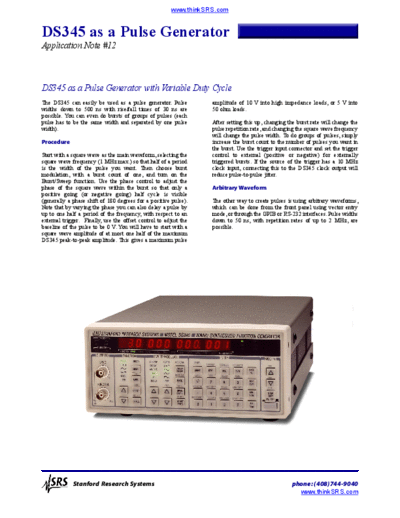Service Manuals, User Guides, Schematic Diagrams or docs for : Stanford Research Systems www.thinksrs.com-DS345_duty_cycle
<< Back | HomeMost service manuals and schematics are PDF files, so You will need Adobre Acrobat Reader to view : Acrobat Download Some of the files are DjVu format. Readers and resources available here : DjVu Resources
For the compressed files, most common are zip and rar. Please, extract files with Your favorite compression software ( WinZip, WinRAR ... ) before viewing. If a document has multiple parts, You should download all, before extracting.
Good luck. Repair on Your own risk. Make sure You know what You are doing.
Image preview - the first page of the document

>> Download www.thinksrs.com-DS345_duty_cycle documenatation <<
Text preview - extract from the document
www.thinkSRS.com
DS345 as a Pulse Generator
Application Note #12
DS345 as a Pulse Generator with Variable Duty Cycle
The DS345 can easily be used as a pulse generator. Pulse amplitude of 10 V into high impedance loads, or 5 V into
widths down to 500 ns with rise/fall times of 30 ns are 50 ohm loads.
possible. You can even do bursts of groups of pulses (each
pulse has to be the same width and separated by one pulse After setting this up, changing the burst rate will change the
width). pulse repetition rate, and changing the square wave frequency
will change the pulse width. To do groups of pulses, simply
Procedure increase the burst count to the number of pulses you want in
the burst. Use the trigger input connector and set the trigger
Start with a square wave as the main waveform, selecting the control to external (positive or negative) for externally
square wave frequency (1 MHz max.) so that half of a period triggered bursts. If the source of the trigger has a 10 MHz
is the width of the pulse you want. Then choose burst clock input, connecting this to the DS345 clock output will
modulation, with a burst count of one, and turn on the reduce pulse-to-pulse jitter.
Burst/Sweep function. Use the phase control to adjust the
phase of the square wave within the burst so that only a Arbitrary Waveform
positive going (or negative going) half cycle is visible
(generally a phase shift of 180 degrees for a positive pulse). The other way to create pulses is using arbitrary waveforms,
Note that by varying the phase you can also delay a pulse by which can be done from the front panel using vector entry
up to one half a period of the frequency, with respect to an mode, or through the GPIB or RS-232 interfaces. Pulse widths
external trigger. Finally, use the offset control to adjust the down to 50 ns, with repetition rates of up to 2 MHz, are
baseline of the pulse to be 0 V. You will have to start with a possible.
square wave amplitude of at most one half of the maximum
DS345 peak-to-peak amplitude. This gives a maximum pulse
Stanford Research Systems phone: (408)744-9040
www.thinkSRS.com
◦ Jabse Service Manual Search 2024 ◦ Jabse Pravopis ◦ onTap.bg ◦ Other service manual resources online : Fixya ◦ eServiceinfo